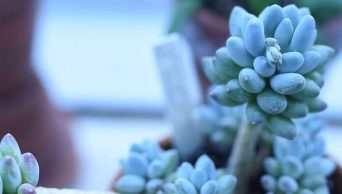The Pachyphytum glutinicaule has fleshy leaves, which make it an excellent choice for indoor and outdoor gardens because of its ability to survive drought conditions.
Pachyphytum glutinicaule care can be intimidating at first glance, but this guide will help you in your journey of taking care of the Pachyphytum Glutinicaule succulent plant.
This guide includes all the information on how to propagate Pachyphytum Glutinicaule plants and Pachyphytum care.
Overview
Pachyphytum glutinicaule plants, commonly known as Pachyphytum ‘Sticky Moonstones’, are slow-growing, small succulents native to Mexico that belong to the family Crassulaceae.
It has fleshy leaves that range in color from green to orange and even purple. The leaves form a loosely shaped rosette.
Pachyphytum glutinicaule blooms with small bell-shaped flowers in the spring and summer. These white and red flowers grow on a long inflorescence.
How To Care for Pachyphytum Glutinicaule
Pachyphytum glutinicaule care can be challenging to find information about, but I have put all the Pachyphytum care tips down for you in one place.
Below you’ll find the most important information you need to know about caring for Pachyphytum glutinicaule.
Sun Exposure & Light Requirements
Pachyphytum glutinicaule succulent care is easy if you give your plant the correct amount of light it needs.
The Pachyphytum glutinicaule succulents need full sun or partial shade.
When grown outdoors, Pachyphytum glutinicaule requires full sun.
It will need bright light from a window or artificial lighting when grown indoors.
They can tolerate some shade, but giving these succulents too much shade is not recommended.
You may place Pachyphytum glutinicaule in a north-facing window to reduce the intensity of sunlight and prevent plants from becoming burned.
Watering Requirements
Pachyphytum glutinicaule is a succulent plant that is not water-demanding.
This plant will do well in dry conditions and as it can survive without good watering for long periods (over two weeks). It can be watered weekly.
As a general rule, it should only be watered when the soil is dry. Pachyphytum glutinicaule must not be overwatered, as it has very delicate roots that rot easily when too much water is available.
When this succulent plant is watered, the water should be very slowly poured into the soil so it can fully drain between waterings.
You should also avoid getting the leaves wet, as this can lead to the leaves rotting and dropping.
Soil Requirements
Pachyphytum glutinicaule plants require well-draining soil like cactus soil or succulent soil mix.
A well-draining soil mix will prevent the roots from rotting and keep the soil fresh for longer.
You can add a handful of sand, perlite, or pumice to their potting mix to improve drainage and aeration in the soil.
Pumice will improve drainage, perlite will increase aeration, and sand adds weight to the soil mix.
You can add a handful of sand to their potting mix to improve drainage and aeration when using a regular soil blend.
Temperature and Humidity
The optimal temperature range and humidity for the Pachyphytum glutinicaule succulents should be around 68° – 80° Fahrenheit at night, with a relative humidity of around 40%.
This succulent should not be exposed to temperature fluctuations for extended periods.
They also prefer a well-ventilated environment because these succulents are prone to fungal rot in a humid or stagnant environment.
Fertilizing
Pachyphytum glutinicaule succulents only need to be fertilized once a month, during the growing season, and with a water-soluble fertilizer diluted to one-half strength.
This succulent can store nutrients from the soil, allowing it to grow without needing much in the way of nutrients.
They are sensitive to fertilizer burn (leaves turning black), so you should dilute your fertilizer by half strength with water and ensure it is 100% soluble before applying.
Other than during the growing season, this plant does not need to be fertilized. It is very efficient at storing nutrients.
Potting and Repotting
Pachyphytum glutinicaule is a slow-growing Pachyphytum and does not have to be repotted often. It can stay in the same pot for years, even decades, if given proper care.
You will need to repot when it becomes too big for its pot, and you want to give your plant more space.
You will also need to repot it if it has become root-bound in its current pot.
This succulent can be planted in a little bit bigger pot than the plant’s current pot.
It can also be planted in the ground if you live in an area where Pachyphytum glutinicaule can be planted outside during the growing season.
Pruning
Pachyphytum glutinicaule plants tend to have a very slow growth rate, so most Pachyphytums don’t need pruning at all.
However, you can remove dead or diseased leaves.
These plants will survive pruning, though you should only prune Pachyphytums that are showing signs of wilt and distress (usually after they have been knocked over).
If Pachyphytum plants are being grown in containers, it is good to remove the old growth as this will keep your succulent from getting rootbound.
Pachyphytum glutinicaule plants do not respond well to hard pruning.
Pests and Diseases
Pachyphytum glutinicaule are susceptible to various pests, and though none seriously threaten the plant’s life, they can prove problematic when left unattended.
The most common Pachyphytum glutinicaule pests are:
- Mealybugs: They are small, soft-bodied insects that feed on the leaves and suck out the plant’s sugary sap.
- Aphids: They are tiny, soft-bodied pests that will cluster in groups around older growths. They consume the plant by sucking out its juices.
- Whiteflies: They are tiny white bugs. They lay their eggs under the leaves, and the nymphs will feed off the plant by sucking out its juices.
The most common Pachyphytum glutinicaule diseases are:
- Root Rot: This succulent is susceptible to root rot caused by fungi and other microorganisms. Its roots will rot away, leaving the top to wither and die.
- Pestalotiopsis Fungus: Pestalotiopsis is a common disease in Pachyphytum glutinicaule that is often mistaken for a pest problem because it causes spots on the leaves, much like mealybugs would.
The best way to prevent pests and diseases is to keep your plants healthy through proper care.
It will be harder for the pests to get a foothold on healthy Pachyphytum Glutinicaule plants than weak ones.
Healthy plants should also be more resistant to disease and nip pest problems in the bud before they get serious.
It is also a good idea to quarantine your plants after purchasing them or transferring them from one house area to another.
Any plant that has signs of pests or diseases should be immediately isolated and treated, if possible.
Generally speaking, Pachyphytum Glutinicaule will not be attacked by any serious pests or diseases unless they are weak for some reason (overwatering, underwatering, improper temperatures).
But there is always a possibility you can encounter them, especially if you’re planning on growing your succulents outside.
How to Care for Pachyphytum Glutinicaule in Winter
Pachyphytum glutinicaule succulent plants grow within USDA hardiness zones 9a-11.
They are susceptible to frostbite and root rot, so you must provide Pachyphytum with winter protection.
Here are some things you can do to protect your Pachyphytum glutinicaule plants during the winter:
- Pachyphytum glutinicaule can tolerate light frosts, but heavy freezes may cause the Pachyphytum leaves to fall off. Pachyphytum can be placed outside during warm summer months and brought inside where they will have a nice winter vacation, then returned outdoors when spring arrives.
- This plant requires at least 6 hours of direct sunlight each day; otherwise, the Pachyphytum plants can become leggy. Pachyphytum prefers bright shade and plenty of protection from hot afternoon sun rays as this could cause Pachyphytum leaf burn.
- Pachyphytum is a succulent plant and does not like being overwatered. It only needs to be watered during winter when its soil has completely dried out. Pachyphytum prefers to dry out slightly between waterings but should never get too dry as this could cause Pachyphytum leaves to shrivel up.
- It will require less water during the winter months than it does during the summer.
- Pachyphytum plants can grow well in a sunny window during winter, but they should be taken outside when the weather is warm enough. They can also be placed near an indoor, artificial plant grow light.
How To Propagate Pachyphytum Glutinicaule
Pachyphytum glutinicaule can be easily propagated by leaf cuttings or stem cuttings.
Leaf Cuttings
How to propagate Pachyphytum glutinicaule by leaf cuttings:
- Remove a leaf from the mother plant.
- Allow the leaf cutting to callous for a few days.
- Put it into well-draining soil.
- Keep it watered in a warm, bright location until new growth appears.
It will take a few months for Pachyphytum glutinicaule leaf cuttings to root. Then you can transplant your new plants into larger pots.
Stem Cuttings
How to propagate Pachyphytum glutinicaule by stem cuttings:
- Take a stem from your plant.
- Allow it to callous for a few days before planting.
- Once the cuttings have been callous for a few days, they should be put into well-draining soil.
- Keep the new cuttings watered in a warm, bright location until new growth appears.
It is typical for Pachyphytum glutinicaule stem cuttings to take 3-4 months to establish a healthy root system. Then, you can transplant the plants into larger pots.
Is the Pachyphytum Glutinicaule Toxic?
Pachyphytum Glutinicaule is not toxic to people or animals.
However, washing your hands after touching this succulent is always recommended.
Final Thoughts
The Pachyphytum glutinicaule succulent can be planted indoors or outdoors, but it prefers dry climates with full sun exposure.
It is drought tolerant once established, so little maintenance is required after planting it outside!
You will enjoy its beauty year-round without having to worry about watering it too often (or at all!).
It also has low water requirements, making it perfect for those who want a more sustainable lifestyle!







